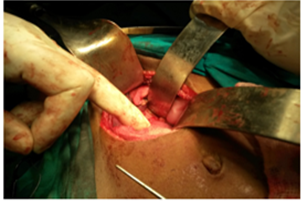Evaluation of early postoperative outcome of hepatico-duodenostomy and rouxen-y hepaticojejunostomy for the treatment of choledochal cyst: A comparative study
Abstract
Purpose: Choledochal cyst is a developmental defect of the biliary channel with a wide spectrum of complications. Excision of cyst & biliary reconstruction is the treatment of choice. In our country, Roux-en-Y hepaticojejunostomy (RYHJ) and Hepaticoduodenostomy (HD) both are performed for biliary reconstruction. In this study we have tried to compare the outcome of both of the procedures and whether anyone has superiority in terms of operative technique or early postoperative outcome. Methods: It is an observational type of prospective comparative study. The study period was from January 2016 to February 2017. The study has done in the Pediatric Surgery Department of BSMMU, Dhaka, Bangladesh. This included 36 patients with choledochal cyst. The study population was divided into two groups according to the method used for biliary reconstruction. Group A included 18 patients who underwent HD, while group B included 18 patients treated with RYHJ. Demographic and outcome data were compared using an unpaired t-test. Results: The mean operative time was shorter in group A in 87.78 ± 19.94 minutes than in group B, 166.11 ± 34.45 minutes, p-value <0.001, which is significant. Hospital stay was comparable in both groups 6.83 ± 1.88 days in group A and 9.23 ± 2.27 days in group B, the p-value is significant. There were no major intraoperative complications in either group. Four patients of group B and one patient of group A were prolonged ileus. Total four patients had anastomotic leakage, one from group A and three from the group. One patient of each group needed re-laparotomy, the rest of the two patients was improved after conservative management. Conclusions: In this study, HD required less operative time and avoidance of intestinal anastomosis, less hospital stay time, and no severe complications in comparison to RYHJ.
Downloads
References
Holcomb III GW, Murphy P J, Ostlie D J, 2014, Aschcraft’s “Pediatric Surgery”, 6th edition, Elsevier, p 603.
Kasai M, Asakura Y, Tamia Y, 1970, Surgical treatment of choledochal cyst. Ann Surg, 172, 844-51.
Todani T, Watanabe Y, Toki A, Urushihara N, & Sato, Y, 1988. Reoperation for congenital choledochal cyst, Annals of Surgery, 207(2), 142–147.
Todani T, Watanabe Y, Urushihara N, Noda T, Morotomi Y, 1995, Biliary complications after excisional procedure for choledochal cyst. Journal of Pediatric Surgery, 30, 478-481.
Patil V, Kanetkar V, Talpallikar MC, 2012, Hepaticoduodenostomy for biliary reconstruction after surgical resection of choledochal cyst: a 25-year experience, Indian J Surg. DOI 10,1007/s12262-012-0783-2.
Elhalaby E, Hashish A, Elbarbary M, Elwagish M, 2005, Roux-en-Y hepaticojejunostomy versus hepaticoduodenostomy for reconstruction after excision of choledochal cysts in children. Annal of Pediatric Surgery. 1, 79-85
Todani T, Watanabe Y, Toki A, Urushihara N.1987 Carcinoma related to choledochal cysts with internal drainage operations. Surg Gynecol Obstet. Jan 164(1), 61-4.
Tsuchida Y, Takahashi A, Suzuki N, Kuroiwa M, Murai H, Toki F, Kawarasaki H, Hashizume K, Honna T, 2002, Development of intrahepatic biliary stones after excision of choledochal cysts, Journal of Pediatric Surgery, 37 (2)165-167.
Takada K, Yamataka A, Kobayashi H, OkadaY, Yanai T, Lane GJ, Miyano T, 2003, Forme fruste choledochal cyst: long-term follow-up with special reference to surgical technique, Journal of Pediatric Surgery, 38 (12), 1833-1836.
Santore MT, Behar BJ., Blinman TA., et al .2011, Hepaticoduodenostomy vs hepaticojejunostomy for reconstruction after resection of choledochal cyst. Journal Pediatr Surg, 46, 209-291.
Shimotakahara, A., Yamataka, A., Yanai, T., 2005, Roux-en-Y hepaticojejunostomy or hepaticoduodenostomy for biliary reconstruction during the surgical treatment of choledochal cyst: Which is better? Pediatric Surgery International, 21, 5-7.
Shimotakahara A, Yamataka A, Kobayashi H, OkadaY, Yanai T, Lane GJ, Miyano T, 2003, Forme fruste choledochal cyst: long-term follow-up with special reference to surgical technique, Journal of Pediatric Surgery, 38 (12), 1833-1836.
Todani T, Watanabe Y, Toki A, Hara H, 2002, Hilar duct carcinoma developed after cyst excision followed by hepaticoduodenostomy. In: Koyanagi Y, Aoki T(eds) Pancreaticobiliary maljunction. Igakutosho shuppan, Tokyo, pp 17-21.



























